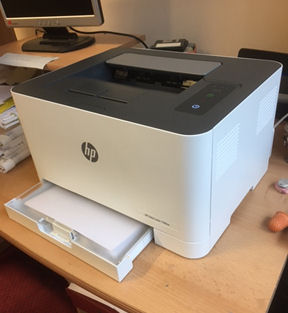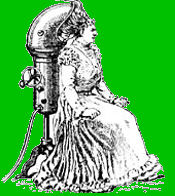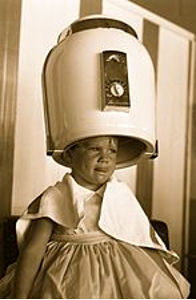Dates for your Diary
AGM – Saturday 5th December 11.00 am
Museum opening times
Closed until further notice.
100 Club
Suspended pending re-opening of museum.
Royal Mail ‘Star Trek’ Stamps
‘Star Trek’ has been on our TV and cinema screens since 1966 (1969 in the UK) and is still going strong today. To mark its incredible success, the Royal Mail is ‘boldly going where they’ve never gone before’ and are releasing a set of 12 stamps featuring characters from this hugely popular franchise. So if you are both a stamp collector and a ‘Trekkie’ then look out for this stamp set which will be on sale from 13th November.
New Colour Printer
We may be closed but we have been working behind the scenes. We have now invested in a new colour laser printer to replace our ageing black and white one. In addition, we’ve also bought a new A3 laminator and bespoke Perspex screens for the café area are currently on order in readiness for our grand re-opening, whenever that may be!

The museum’s new colour laser printer
Annual General Meeting
The museum’s constitution requires the holding of an Annual General Meeting. Consequently, even though we remain closed, the AGM will be going ahead. It will be held at the museum on Saturday 5th December at 11am. Letters and voting slips will be sent out to all members in due course and, because of the need for social distancing and contact tracing, we ask that you book your place at the meeting by either emailing the museum at abertillerymuseum@btconnect.com or by telephoning our Chairperson, Mrs Peggy Bearcroft, on 01495 616028. We look forward to seeing you.
The Hairdyer
If I was only allowed to choose one thing to take with me to a desert island, (ignoring the lack of power of course) it would be, without hesitation, my hairdryer!

The very first hairdryer was invented by a Frenchman, Alexander Godefroy, in 1890. It was neither portable nor handheld and consisted of a bonnet that attached to the himney of a gas stove. He put it to use in his hair salon.
It wasn’t until the 1920’s that hairdryers started to become handheld. This was thanks to innovations of companies such as the National Stamping and Electricworks Company to name but one. Even so, these early handheld hairdryers were still heavy, often weighing several pounds as they were made of metal, and they were also prone to overheating. They were not very powerful either, only around 100watts (the modern hairdryer is around 2000watts) and there were instances of users being electrocuted. Plastic handheld hairdryers did not start until around the middle of the 20th century. Although the plastic made them lighter, they were still much heavier than today’s modern hairdryers.
It’s not just hairdryers that have evolved; hairstyles too have changed radically. When my mother was a young woman, it was usually the custom for women to have their hair ‘permed’. This entailed using chemicals and heat to ‘set’ the hair into a curly style. My mother never washed and dried her hair herself, instead, once a week, she would visit a salon for a ‘wash & set’, and would it have it permed every 3 months or so.

© By BeenAroundAWhile at en.wikipedia, CC BY-SA 3.0
By this time the rigid-hood hairdryer was the norm in hair salons and a few salons still have these today.
 In the early 1970s a home version of the hood dryer was produced by Ronson, they called it their ‘Escort 2000’ and yours truly had one! In addition to the ‘hood’, it also had two attachments; a styling comb and brush. I’m pleased to say the museum has one of these dryers in its archive albeit not mine which is long gone.
In the early 1970s a home version of the hood dryer was produced by Ronson, they called it their ‘Escort 2000’ and yours truly had one! In addition to the ‘hood’, it also had two attachments; a styling comb and brush. I’m pleased to say the museum has one of these dryers in its archive albeit not mine which is long gone.
Despite relying on perms and sets, my late mother still owned a hairdryer. It was a very heavy, ivory coloured dryer that was still it its original cardboard box and I think it must have been purchased in the 1950’s. I recall it was very prone to overheating and very inefficient at drying hair!
I came across it at my parents’ home after my father died in 2014 and, I’m sorry to say, I took it to a recycling centre, never giving a thought of donating it to the museum!

Over the years, hairdryers have become smaller, lighter and more powerful. With the popularity of air travel in the 1970’s, hairdryers started to have not only folding handles for compactness but also ‘duel voltage’ capability to make them seable in countries that had a different electrical system to ours. One favourite of mine, that I had for years, was the Ronson Rio, pictured above, which was a very unusual, rectangular shaped dryer that was very small yet surprisingly powerful.
Today’s modern, low-maintenance, lacquer-free, ‘cut and blow-dry’ hairstyle can be attributed to British born Vidal Sassoon who pioneered it in the mid to late 60s. I was introduced to it in 1975 when, at the age of 16, my mother persuaded me to go to a modern salon and have my hair styled into a sleek, blow-dry style that I could manage myself at home between visits and for that, I am eternally grateful. We chose ‘Philips Hair Studio’ in Ebbw Vale which, in the 1970’s, was the place for young people to have their hair styled and Philip, who prided himself on having well-trained stylists, was one of the very first, if not the first, to introduce blow drying to the South Wales Valleys.
https://en.wikipedia.org/wiki/Hair_dryer
Thanks to professional hairdressers, Philip McCarthy and Simone Hockey for their help with this article.
Sally Murphy
Flat Holm
I am in lockdown in Torfaen as I write this but, as a keen hill walker, I am lucky to have mountains close at hand. Mynydd Maen, which is on the right at Cwmbran on your way down to Newport, is a nearby favourite and gives good views out over the Bristol Channel to Somerset and Avon. The two distinctive islands in the Channel highlight the boundary between England and Wales as Steep Holm lies in England but nearby Flat Holm forms part of Cardiff. Years ago, Flat Holm could only be visited by special arrangement and my husband Colin, and I were lucky to get places on a weekend field trip to the island which was a nature reserve. There was a resident warden and dormitory accommodation for visiting groups. One of the things we did that weekend was collect gulls' eggs. The island is limestone which supports a distinctive low but dense growth of grass – a maritime sward which was and still is, relatively rare. However, the gulls that visited the island had rich food pickings in nearby Cardiff and Barry, foraging in the towns and rubbish tips and the scraps they brought back along with a lot of gull poo, meant that the limestone sward was being swamped by stronger and more luxuriant grasses and plants. By collecting at least some of the eggs (some of which were fed to the warden's chickens) the area of limestone sward was gradually being increased. That was years ago. We haven't been back but it is on my list of places to visit when life eventually returns to normal as day trips are now (or were) available on a regular basis.
What of the history of Flat Holm? Well its name is a clue as it shows the Vikings were there as the word holm is Scandinavian for river island. Flat Holm has long been a place of refuge and sanctuary. St Cadoc made several visits in the 6th century and in 914 a group of Vikings took shelter there having been defeated at Watchet by the Saxons. It is also thought that when Henry VIII suppressed the monasteries in the 16th century, monks from Blackfriars in Cardiff fled to the island. Throughout this time the land was farmed with both arable and pasture land. The old farmhouse was rebuilt during the 18th century and forms the basis for the present group of residential and teaching building. The most distinctive building on Flat Holm is the lighthouse which was one of the last privately owned lighthouses in the country until Trinity House took them over in 1823. The waters around the island were always busy but always dangerous and a shipwreck in 1736 and the associated death of 60 soldiers gave impetus to calls for a lighthouse there. The first light, fired by coal, was lit at the end of 1737; 25 tons of coal were landed on the island each month to keep the light burning. The coal brazier had its limits and following further losses at sea, a new oil lantern was installed and various improvements were made to the tower and lantern in subsequent years, including the building of a foghorn station in 1908, but it was not until 1969 that the light was converted to run on electricity.
Flat Holm also has an interesting naval history as it was selected in the mid 19th century as the site for one of the many fortresses which were built as a defence against an invasion by France. In order to protect the Bristol Channel, fortresses were built at Brean Down, Flat Holm and Lavernock, the work being completed in 1869. The impressive fortifications can still be see (although more easily at Brean Down which is readily accessible) including cannon, the pits built to accommodate them, and the remains of buildings including barracks and the impressive 'walls' built to collect rainwater. Flat Holm also has a claim to fame in the history of radio as when Marconi set up his famous demonstration in Wales in 1897 the two masts were built at Lavernock Point and on Flat Holm – this was the first ever wireless message to go across the sea.
On a more sombre note, the island also has a cholera hospital. In 1883 the Government issued a warning to all British ports about the potential threat of cholera from returning and visiting sailors and this led to the construction of cholera hospitals. The port of Cardiff was potentially at risk in those times of poor living conditions and when, in 1884, three sailors were diagnosed with cholera, they were taken to Flat Holm where a makeshift hospital was set up in a tent. The decision was understandably unpopular with the farmer there, Trinity House, the military, and visitors! A hospital was built in 1886 but not used until 1892 when the number of patients reached a level where a new and larger hospital was needed and built. It eventually fell out of use and was condemned in 1935. In the meantime, the farmhouse had been converted into the Flat Holm Hotel. There were some confrontations with the Cardiff Constabulary, not least over licensing hours, and the hotel eventually closed.
WWII opened a new chapter in the island's history. Over 350 soldiers were stationed there and anti-aircraft guns, modified so as also to be able to aim at ships, were installed along with all the necessary infrastructure, the remains of which can still be seen although use was also made of the Victorian barracks and the old cholera hospital was converted into a NAAFI. Well worth a visit.
Jen Price
REMEMBERING REMEMBRANCE DAY
At the eleventh hour of the eleventh day of the eleventh month in 1918 the guns of war finally fell silent – the Armistice. We remember that event on Remembrance Day, on Remembrance Sunday. All of us try, if we can, to observe two minutes silence at 11a.m. each 11th November – a time for quiet personal reflection and this year, with all that is going on, it seems more important than ever that we observe Remembrance Sunday. Traditionally it is always the second Sunday in November when we, as a nation, take part in organised public memorial services. This year a few will be allowed to go ahead on Sunday 8th November but most of us will be forced to stay at home and watch events on TV.
It all started with a letter published in the London Evening News on 8th May 1919 written by an Australian journalist, Edward George Honey, who proposed a respectful silence to remember those who had given their lives in World War I. It struck a chord and the first two minute silence in Britain was held on 11th November 1919 when King George V asked the public to observe a silence at 11a.m., requesting that “in perfect stillness the thoughts of everyone may be concentrated on reverent remembrance of the glorious dead”. The day was known as Armistice Day until 1930 and as Remembrance Day since then.
We are all familiar with the televised memorial service held at the Cenotaph in London. A temporary Cenotaph of wood and plaster was replaced, in the years 1919-1920 by the Portland Stone structure which stands today but around the country it was often several years before war memorials were built. Take Abertillery. After some years of discussion as to the form the memorial should take, with suggestions including a new children’s ward at the hospital or a public library, the decision was eventually taken that the ex-servicemen of the town should decide and they opted for a statue. It then took some time to raise the necessary funds and so it was not until 1st December 1926 that the town’s Civic War Memorial in Somerset Street was unveiled. Abertillery’s Armistice Day services were held in various buildings in the town until then.
We think of Remembrance Day as an annual event but, if you have visited the Menin Gate in Ypres, Belgium, you will know that there is a memorial service held there every single evening where buglers playing “The Last Post” cut through the silence of the crowds. No-one who has been there can fail to have been moved by the service or by the horror of the 54,000 names on the Menin Gate – soldiers who fell in Belgium but who have no known grave. Although Remembrance Day was initially about remembering those soldiers from Commonwealth countries who fell in the Great War, it has come to signify a service of remembrance for all those who have suffered in war including in more recent conflicts.
We can’t remember Remembrance Day without talking about the red poppies sold by the Royal British Legion to help needy members of the armed services. The poppy is a symbol of the blood spilled in the war and also a symbol for Remembrance Day following the famous poem “In Flanders Field” written by John McCrae who saw poppies growing on the graves of soldiers. He was inspired to write the poem following the death of a young Canadian artillery officer, Lieutenant Alexis Helmer, on 2nd May 1915 in the early days of the bloody Second Battle of Ypres, when a German artillery shell exploded near him. He was serving in the same regiment as Major John McCrae, a military doctor and artillery commander. The chaplain was unavailable and so, as brigade doctor, McCrae was asked to conduct the burial service. It is believed that McCrae began writing his poem that same evening. It was published in Punch on 8th December 1915 and an American humanitarian named Moina Michael, after reading the poem, began wearing and giving poppies to people to wear in November 1918 to honour fallen soldiers. The American Legion officially adopted the poppy in 1920 and the Royal British Legion in 1921.
Jen Price
In Flanders Fields
By John McCrae
In Flanders fields the poppies blow
Between the crosses, row on row,
That mark our place; and in the sky
The larks, still bravely singing, fly
Scarce heard amid the guns below.
We are the Dead. Short days ago
We lived, felt dawn, saw sunset glow,
Loved and were loved, and now we lie,
In Flanders fields.
Take up our quarrel with the foe:
To you from failing hands we throw
The torch; be yours to hold it high.
If ye break faith with us who die
We shall not sleep, though poppies grow
In Flanders fields.

Top Of Page
